Milwaukee M18 Fuel 2981-21 Handleiding
Milwaukee
Slijpmachine
M18 Fuel 2981-21
Bekijk gratis de handleiding van Milwaukee M18 Fuel 2981-21 (15 pagina’s), behorend tot de categorie Slijpmachine. Deze gids werd als nuttig beoordeeld door 31 mensen en kreeg gemiddeld 4.7 sterren uit 16 reviews. Heb je een vraag over Milwaukee M18 Fuel 2981-21 of wil je andere gebruikers van dit product iets vragen? Stel een vraag
Pagina 1/15

Cat. No. / No de cat.
2980-20, 2981-20
M18 FUEL™ 4-1/2" - 6" BRAKING GRINDER
MEULEUSE À FREIN DE 115 À 150 (4-1/2" - 6") M18 FUEL™mm mm
RECTIFICADORA CON FRENO DE 115 (4-1/2" - 6") mm mm A 150
M18 FUEL™
OPERATOR'S MANUAL
MANUEL de L'UTILISATEUR
MANUAL del OPERADOR
WARNING To reduce the risk of injury, user must read and understand operator's manual.
AVERTISSEMENT An de réduire le risque de blessures, l'utilisateur doit lire et bien
comprendre le manuel.
ADVERTENCIA Para reducir el riesgo de lesiones, el usuario debe leer y entender el manual.

2
GENERAL POWER TOOL
SAFETY WARNINGS
WARNING
Read all safety warnings, instruc-
tions, illustrations and specica-
tions provided with this power tool. Failure to
follow all instructions listed below may result in
electric shock, re and/or serious injury. Save all
warnings and instructions for future reference.
The term "power tool" in the warnings refers to your
mains-operated (corded) power tool or battery-oper-
ated (cordless) power tool.
WORK AREA SAFETY
• Keep work area clean and well lit. Cluttered or dark
areas invite accidents.
• Do not operate power tools in explosive atmo-
spheres, such as in the presence of ammable
liquids, gases or dust. Power tools create sparks
which may ignite the dust or fumes.
• Keep children and bystanders away while operat-
ing a power tool. Distractions can cause you to lose
control.
ELECTRICAL SAFETY
• Power tool plugs must match the outlet. Never
modify the plug in any way. Do not use any
adapter plugs with earthed (grounded) power
tools. Unmodied plugs and matching outlets will
reduce risk of electric shock.
• Avoid body contact with earthed or grounded
surfaces, such as pipes, radiators, ranges and
refrigerators. There is an increased risk of electric
shock if your body is earthed or grounded.
• Do not expose power tools to rain or wet condi-
tions. Water entering a power tool will increase the
risk of electric shock.
• Do not abuse the cord. Never use the cord for
carrying, pulling or unplugging the power tool.
Keep cord away from heat, oil, sharp edges or
moving parts. Damaged or entangled cords increase
the risk of electric shock.
• When operating a power tool outdoors, use an
extension cord suitable for outdoor use. Use of
a cord suitable for outdoor use reduces the risk of
electric shock.
• If operating a power tool in a damp location is
unavoidable, use a ground fault circuit interrupter
(GFCI) protected supply. Use of an GFCI reduces
the risk of electric shock.
PERSONAL SAFETY
• Stay alert, watch what you are doing and use
common sense when operating a power tool. Do
not use a power tool while you are tired or under
the inuence of drugs, alcohol or medication. A
moment of inattention while operating power tools
may result in serious personal injury.
• Use personal protective equipment. Always wear
eye protection. Protective equipment such as a dust
mask, non-skid safety shoes, hard hat or hearing
protection used for appropriate conditions will reduce
personal injuries.
• Prevent unintentional starting. Ensure the switch
is in the off-position before connecting to power
source and/or battery pack, picking up or carrying
the tool. Carrying power tools with your nger on the
switch or energizing power tools that have the switch
on invites accidents.
• Remove any adjusting key or wrench before
turning the power tool on. A wrench or a key left
attached to a rotating part of the power tool may result
in personal injury.
• Do not overreach. Keep proper footing and bal-
ance at all times. This enables better control of the
power tool in unexpected situations.
• Dress properly. Do not wear loose clothing or
jewelry. Keep your hair and clothing away from
moving parts. Loose clothes, jewelry or long hair
can be caught in moving parts.
• If devices are provided for the connection of dust
extraction and collection facilities, ensure these
are connected and properly used. Use of dust
collection can reduce dust-related hazards.
• Do not let familiarity gained from frequent use
of tools allow you to become complacent and
ignore tool safety principles. A careless action
can cause severe injury within a fraction of a second.
POWER TOOL USE AND CARE
• Do not force the power tool. Use the correct
power tool for your application. The correct power
tool will do the job better and safer at the rate for
which it was designed.
• Do not use the power tool if the switch does not
turn it on and off. Any power tool that cannot be
controlled with the switch is dangerous and must be
repaired.
• Disconnect the plug from the power source and/
or remove the battery pack, if detachable, from
the power tool before making any adjustments,
changing accessories, or storing power tools.
Such preventive safety measures reduce the risk of
starting the power tool accidentally.
• Store idle power tools out of the reach of children
and do not allow persons unfamiliar with the
power tool or these instructions to operate the
power tool. Power tools are dangerous in the hands
of untrained users.
• Maintain power tools and accessories. Check for
misalignment or binding of moving parts, break-
age of parts and any other condition that may
affect the power tool’s operation. If damaged,
have the power tool repaired before use. Many
accidents are caused by poorly maintained power
tools.
• Keep cutting tools sharp and clean. Properly
maintained cutting tools with sharp cutting edges are
less likely to bind and are easier to control.
• Use the power tool, accessories and tool bits etc.
in accordance with these instructions, taking into
account the working conditions and the work to
be performed. Use of the power tool for operations
different from those intended could result in a hazard-
ous situation.
• Keep handles and grasping surfaces dry, clean
and free from oil and grease. Slippery handles
and grasping surfaces do not allow for safe handling
and control of the tool in unexpected situations.
BATTERY TOOL USE AND CARE
• Recharge only with the charger specied by the
manufacturer. A charger that is suitable for one type
of battery pack may create a risk of re when used
with another battery pack.
• Use power tools only with specically designated
battery packs. Use of any other battery packs may
create a risk of injury and re.
• When battery pack is not in use, keep it away
from other metal objects, like paper clips, coins,
keys, nails, screws or other small metal objects,
that can make a connection from one terminal to
another. Shorting the battery terminals together ma
cause burns or a re.

4
• Support panels or any oversized workpiece to
minimize the risk of wheel pinching and kickback.
Large workpieces tend to sag under their own weight.
Supports must be placed under the workpiece near
the line of cut and near the edge of the workpiece on
both sides of the wheel.
• Use extra caution when making a “pocket cut”
into existing walls or other blind areas. The pro-
truding wheel may cut gas or water pipes, electrical
wiring or objects that can cause kickback.
Safety Warnings Specic for Sanding Operations:
• Do not use excessively oversized sanding disc
paper. Follow manufacturers recommendations,
when selecting sanding paper. Larger sanding
paper extending beyond the sanding pad presents a
laceration hazard and may cause snagging, tearing
of the disc or kickback.
Safety Warnings Specic for Wire Brushing Op-
erations:
• Be aware that wire bristles are thrown by the
brush even during ordinary operation. Do not
overstress the wires by applying excessive load
to the brush. The wire bristles can easily penetrate
light clothing and/or skin.
• If the use of a guard is recommended for wire
brushing, do not allow any interference of the
wire wheel or brush with the guard. Wire wheel
or brush may expand in diameter due to work load
and centrifugal forces.
Additional Safety Warnings
•
WARNING
To reduce the risk of injury in ap-
plications that produce a consid-
erable amount of dust, use an OSHA compliant
dust extraction solution in accordance with the
solution’s operating instructions.
• Always use common sense and be cautious when
using tools. It is not possible to anticipate every
situation that could result in a dangerous outcome.
Do not use this tool if you do not understand these
operating instructions or you feel the work is beyond
your capability; contact Milwaukee Tool or a trained
professional for additional information or training.
• Maintain labels and nameplates. These carry im-
portant information. If unreadable or missing, contact
a MILWAUKEE service facility for a free replacement.
•
WARNING
Some dust created by power sanding,
sawing, grinding, drilling, and other
construction activities contains chemicals known to
cause cancer, birth defects or other reproductive
harm. Some examples of these chemicals are:
• lead from lead-based paint
• crystalline silica from bricks and cement and other
masonry products, and
• arsenic and chromium from chemically-treated lumber.
Your risk from these exposures varies, depending on
how often you do this type of work. To reduce your
exposure to these chemicals: work in a well ventilated
area, and work with approved safety equipment, such
as those dust masks that are specially designed to
lter out microscopic particles.
SPECIFICATIONS
• Do not position your body in the area where
power tool will move if kickback occurs. Kickback
will propel the tool in direction opposite to the wheel’s
movement at the point of snagging.
• Use special care when working corners, sharp
edges etc. Avoid bouncing and snagging the ac-
cessory. Corners, sharp edges or bouncing have a
tendency to snag the rotating accessory and cause
loss of control or kickback.
• Do not attach a saw chain woodcarving blade or
toothed saw blade. Such blades create frequent
kickback and loss of control.
Safety Warnings Specic for Grinding and Abra-
sive Cutting-Off Operations:
• Use only wheel types that are recommended for
your power tool and the specic guard designed
for the selected wheel. Wheels for which the power
tool was not designed cannot be adequately guarded
and are unsafe.
• The grinding surface of centre depressed wheels
must be mounted below the plane of the guard lip.
An improperly mounted wheel that projects through
the plane of the guard lip cannot be adequately
protected.
• The guard must be securely attached to the power
tool and positioned for maximum safety, so the
least amount of wheel is exposed towards the
operator. The guard helps to protect the operator
from broken wheel fragments, accidental contact
with wheel and sparks that could ignite clothing.
• Wheels must be used only for recommended
applications. For example: do not grind with the
side of cut-off wheel. Abrasive cut-off wheels are
intended for peripheral grinding, side forces applied
to these wheels may cause them to shatter.
• Always use undamaged wheel anges that are of
correct size and shape for your selected wheel.
Proper wheel anges support the wheel thus reducing
the possibility of wheel breakage. Flanges for cut-off
wheels may be different from grinding wheel anges.
• Do not use worn down wheels from larger power
tools. Wheel intended for larger power tool is not
suitable for the higher speed of a smaller tool and
may burst.
Additional Safety Warnings Specic for Abrasive
Cutting-Off Operations:
• Do not “jam” the cut-off wheel or apply excessive
pressure. Do not attempt to make an excessive
depth of cut. Overstressing the wheel increases
the loading and susceptibility to twisting or binding
of the wheel in the cut and the possibility of kickback
or wheel breakage.
• Do not position your body in line with and behind
the rotating wheel. When the wheel, at the point of
operation, is moving away from your body, the pos-
sible kickback may propel the spinning wheel and
the power tool directly at you.
• When wheel is binding or when interrupting a cut
for any reason, switch off the power tool and hold
the power tool motionless until the wheel comes
to a complete stop. Never attempt to remove the
cut-off wheel from the cut while the wheel is in
motion otherwise kickback may occur. Investigate
and take corrective action to eliminate the cause of
wheel binding.
• Do not restart the cutting operation in the work-
piece. Let the wheel reach full speed and care-
fully re-enter the cut. The wheel may bind, walk
up or kickback if the power tool is restarted in the
workpiece."
Product specificaties
| Merk: | Milwaukee |
| Categorie: | Slijpmachine |
| Model: | M18 Fuel 2981-21 |
Heb je hulp nodig?
Als je hulp nodig hebt met Milwaukee M18 Fuel 2981-21 stel dan hieronder een vraag en andere gebruikers zullen je antwoorden
Handleiding Slijpmachine Milwaukee
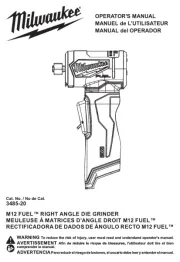
19 Augustus 2025
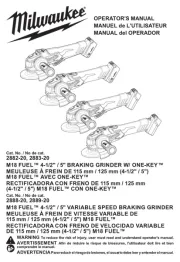
19 Augustus 2025
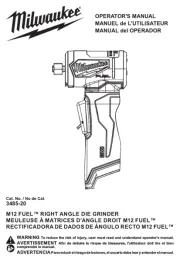
18 Augustus 2025
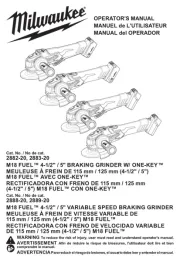
18 Augustus 2025
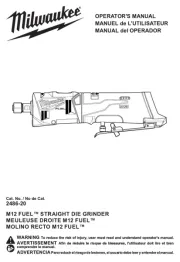
18 Augustus 2025
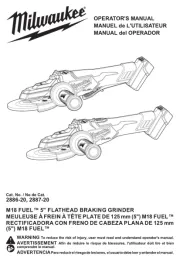
18 Augustus 2025
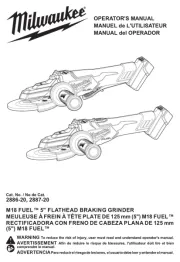
14 Juli 2025
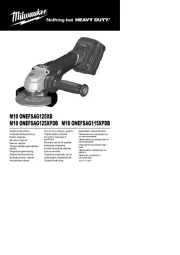
4 April 2025
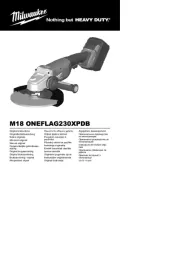
4 April 2025
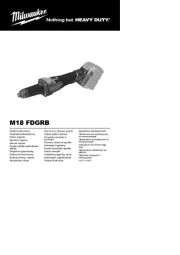
4 April 2025
Handleiding Slijpmachine
- Genesis
- Vonroc
- Verto
- Hitachi
- Flex
- Dotco
- Tryton
- Fein
- Powerfix
- Cotech
- Power Craft
- Skil
- Meec Tools
- Ergofix
- Felisatti
Nieuwste handleidingen voor Slijpmachine
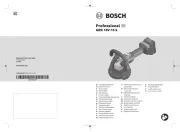
15 September 2025
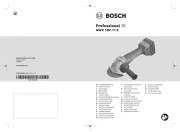
15 September 2025
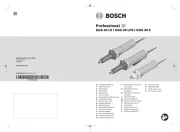
15 September 2025
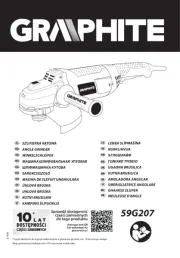
13 September 2025
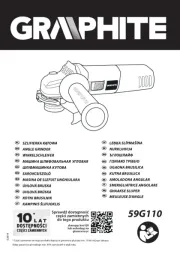
12 September 2025
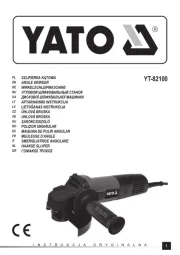
12 September 2025
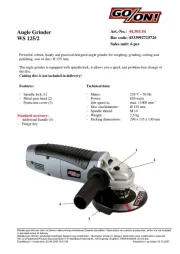
7 September 2025
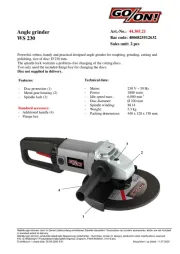
7 September 2025
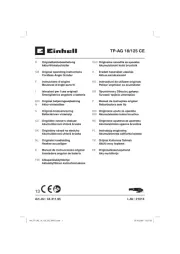
2 September 2025
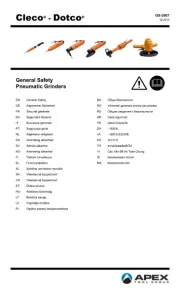
2 September 2025